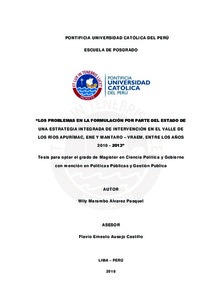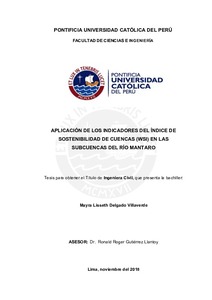| dc.contributor.advisor | Cánepa Koch, Gisela Elvira | |
| dc.contributor.author | Treviños Arana, Walter Fernando | |
| dc.date.accessioned | 2023-09-05T15:28:35Z | |
| dc.date.available | 2023-09-05T15:28:35Z | |
| dc.date.created | 2023 | |
| dc.date.issued | 2023-09-05 | |
| dc.identifier.uri | http://hdl.handle.net/20.500.12404/25904 | |
| dc.description.abstract | La herranza de Santiago es una de las festividades más importantes en las familias ganaderas
del Valle del Mantaro. Esta celebración, de origen campesina, debido a su popularidad y gran
acogida ha sido llevada a contextos urbanos donde se prioriza el disfrute y goce personal. La
presente investigación tiene el objetivo de describir los desafíos y las estrategias que han tenido
las familias realizadoras para desarrollar la fiesta en tiempos de la emergencia sanitaria, así
como también los cambios que venían ocurriendo con la música, los músicos y la celebración
antes de la pandemia del Covid-19. Por este motivo se realizó la visita de campo al Valle de
Mantaro con la intención de encontrar información de primera mano, por medio de entrevistas
a los participantes de la ceremonia; entre ellos a los jefes de familia, los niños, los jóvenes, los
invitados y los músicos, así como también realizar la observación participante. Dentro de los
resultados hallados en este estudio se encuentran que esta celebración se ha adaptado con gran
éxito a este tiempo de crisis haciendo uso de diversas estrategias entre ellas el uso de las
tecnologías digitales y las redes sociales. De la misma manera, esta adaptación ha ayudado a
que los músicos tradicionales de la herranza se formalicen, conformando agrupaciones y
producciones musicales difundiendo las mismas en redes sociales con el fin de alcanzar el
estatus de músico profesional. Asimismo, se evidenció que actualmente existe el ingreso, de
nuevas sonoridades a la fiesta de la herranza de Santiago. | es_ES |
| dc.description.abstract | The herranza de Santiago is one of the most important festivities in the cattle families of the
Mantaro Valley. This celebration, of peasant origin, due to its popularity and great reception,
has been taken to urban contexts where enjoyment and personal enjoyment is prioritized. The
objective of this research is to describe the challenges and strategies that the filmmaking
families have had to develop the party in times of the health emergency, as well as the changes
that were occurring with the music, the musicians and the celebration before the Covid-19
pandemic. For this reason, the field visit to the Mantaro Valley was carried out with the
intention of finding first-hand information, through interviews with the participants of the
ceremony; including the heads of families, children, youth, guests and musicians, as well as
conduct participant observation. Among the results found in this study, it is found that this
celebration has been adapted with great success to this time of crisis, making use of various
strategies, including the use of digital technologies and social networks. In the same way, this
adaptation has helped the traditional musicians of the herranza to become formalized, forming
groups and musical productions, disseminating them on social networks in order to achieve the
status of professional musician. Likewise, it was evidenced that there is currently the entry of
new sounds to the festival of the herranza de Santiago. | es_ES |
| dc.language.iso | spa | es_ES |
| dc.publisher | Pontificia Universidad Católica del Perú | es_ES |
| dc.rights | info:eu-repo/semantics/openAccess | es_ES |
| dc.rights.uri | http://creativecommons.org/licenses/by-nc-sa/2.5/pe/ | * |
| dc.subject | Música folklórica--Perú--Mantaro, Valle | es_ES |
| dc.subject | Fiestas populares--Perú--Mantaro, Valle | es_ES |
| dc.subject | Herranza de Santiago--Perú--Mantaro, Valle. | es_ES |
| dc.subject | Pandemia de COVID-19, 2020--Perú--Mantaro, Valle--Aspectos culturales | es_ES |
| dc.title | Rito, música y nuevas sonoridades en el Valle del Mantaro: La fiesta familiar de la herranza de Santiago en tiempos de la pandemia del COVID-19 | es_ES |
| dc.type | info:eu-repo/semantics/masterThesis | es_ES |
| thesis.degree.name | Maestro en Musicología | es_ES |
| thesis.degree.level | Maestría | es_ES |
| thesis.degree.grantor | Pontificia Universidad Católica del Perú. Escuela de Posgrado. | es_ES |
| thesis.degree.discipline | Musicología | es_ES |
| renati.advisor.dni | 09144486 | |
| renati.advisor.orcid | https://orcid.org/0000-0002-4686-9938 | es_ES |
| renati.author.dni | 41102920 | |
| renati.discipline | 215067 | es_ES |
| renati.juror | Chocano Paredes, Rodrigo Antonio | es_ES |
| renati.juror | Cánepa Koch, Gisela Elvira | es_ES |
| renati.juror | Sadovnic Morán, Alter | es_ES |
| renati.level | https://purl.org/pe-repo/renati/level#maestro | es_ES |
| renati.type | https://purl.org/pe-repo/renati/type#tesis | es_ES |
| dc.publisher.country | PE | es_ES |
| dc.subject.ocde | https://purl.org/pe-repo/ocde/ford#6.04.04 | es_ES |










